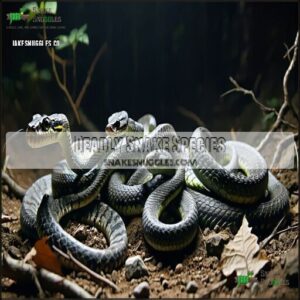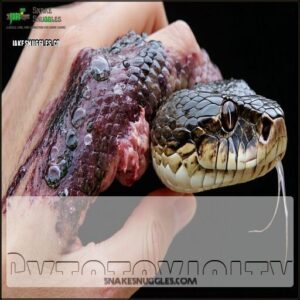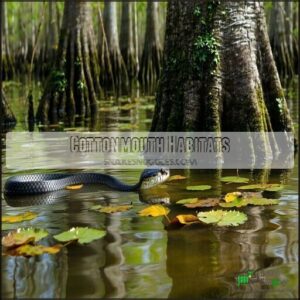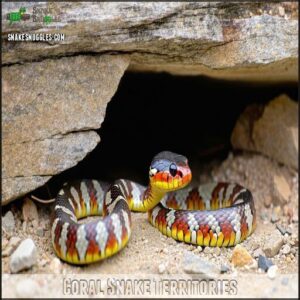This site is supported by our readers. We may earn a commission, at no cost to you, if you purchase through links.
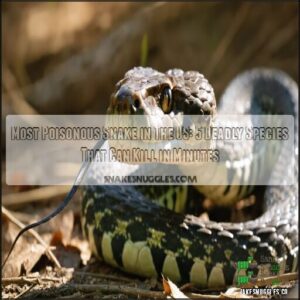 The Eastern Diamondback Rattlesnake reigns as the most poisonous snake in the US, packing enough venom to kill several adults with a single bite.
The Eastern Diamondback Rattlesnake reigns as the most poisonous snake in the US, packing enough venom to kill several adults with a single bite.
You’ll recognize this formidable reptile by its distinctive diamond pattern and warning rattle.
Its hemotoxic venom destroys tissue and prevents blood from clotting—a deadly one-two punch.
While you might feel like playing dead if you encounter one, your best bet is to back away slowly, knowing which regions these serpents call home and how to respond if bitten can be the difference between a scary story and a tragedy, and snake encounters aren’t a game of chance you want to lose.
Table Of Contents
- Key Takeaways
- Deadly Snake Species
- Snake Venom Effects
- Venomous Snake Habitats
- Snake Bite Prevention
- Treating Snake Bites
- Frequently Asked Questions (FAQs)
- How many venomous snakes are there in the United States?
- What is the largest venomous snake?
- Are there venomous snakes in North America?
- What are the deadliest snakes in America?
- Are venomous snakes dangerous?
- What is the most venomous snake in the ocean?
- What are the 4 venomous snakes in the US?
- What is the 1 deadliest snake in the world?
- Which is more poisonous, copperhead or cottonmouth?
- What is the most venomous snake in the United States?
- Conclusion
Key Takeaways
- The Eastern Diamondback Rattlesnake is the most venomous snake in the US, capable of delivering enough hemotoxic venom to kill several adults with a single bite, causing severe tissue damage and internal bleeding.
- You’ll find these deadly snakes primarily in southeastern coastal plains, particularly in Florida and Georgia, where they prefer open habitats with sandy soils, pine flatwoods, and coastal dunes.
- When hiking in snake territory, you’ll reduce your risk by wearing protective footwear, staying on clear paths, using a hiking stick to create vibrations, and remaining vigilant about your surroundings.
- If you’re bitten, you’ll need immediate medical attention – stay calm, call 911, keep the affected area immobilized below heart level, and don’t attempt outdated remedies like sucking out venom or applying tourniquets.
Deadly Snake Species
You’ll encounter several deadly snake species in the United States.
The Eastern Diamondback Rattlesnake ranks as the most venomous due to its potent hemotoxic venom and impressive eight-foot length.
These venomous reptiles, including the Mojave Rattlesnake, Tiger Rattlesnake, and Eastern Coral Snake, can deliver potentially fatal bites that require immediate medical attention.
Eastern Diamondback Rattlesnake
The Eastern Diamondback Rattlesnake’s fearsome reputation is well-earned. As America’s most venomous snake, this beast can reach up to eight feet in length with distinctive diamond patterns.
Its hemotoxic venom causes severe tissue damage and internal bleeding.
You’ll find these apex predators throughout the southeastern coastal plains, particularly in Florida and Georgia. If you hear that characteristic rattle, keep your distance—their bite can be fatal.
Mojave Rattlesnake
While the Eastern Diamondback commands respect for its size, the Mojave Rattlesnake packs a more potent punch.
Found in southwestern deserts, this rattlesnake’s venom combines powerful neurotoxins and cytotoxins that can quickly overwhelm victims.
Four reasons the Mojave deserves your caution:
- Its venom mimics cobra toxins, attacking your nervous system
- Distinctive tan coloration with dark bands makes identification essential
- Prefers arid environments where encounters can happen suddenly
- Responsible for fewer bites but higher fatality potential
Tiger Rattlesnake
While the Mojave packs a punch, the Tiger Rattlesnake delivers a truly lethal strike.
This compact predator holds the title of second most toxic American rattlesnake, found primarily in Arizona and northern Mexico.
Tiger Rattlesnakes prefer rocky slopes and desert habitats where they hunt small mammals and lizards.
Their venom composition is highly potent, containing powerful neurotoxins that can cause rapid respiratory failure.
Despite their small size, they’re among the most venomous snakes in the USA.
Eastern Coral Snake
Unlike the Tiger Rattlesnake, the Eastern Coral Snake doesn’t need size to pack a deadly punch.
You’ll recognize this most venomous snake in USA by its distinctive red, yellow, and black bands.
Its venom composition is primarily neurotoxic, affecting your nervous system rather than destroying tissue.
Though rarely encountered due to their shy nature, coral snake behavior is secretive – they prefer hiding in dry, sandy areas with sparse vegetation or forested regions, which makes them hard to spot due to their shy nature.
Snake Venom Effects
You’ll feel the effects of snake venom within minutes as it attacks your blood, nerves, or tissues depending on whether it’s hemotoxic, neurotoxic, or cytotoxic.
Each venom type works differently in your body, with symptoms ranging from intense pain and swelling to paralysis and tissue death that can prove fatal without immediate medical attention.
Hemotoxicity
While deadly snake species present varying dangers, it’s their venom’s mechanism that determines how they kill.
Hemotoxic venom targets your bloodstream and tissues directly.
When a snake like the eastern diamondback rattlesnake strikes, its venom begins a devastating cascade:
- Destroys red blood cells through hemolysis
- Prevents blood clotting, causing internal bleeding
- Damages blood vessels, dropping blood pressure dangerously
- Creates necrosis and tissue damage around the bite
Toxin response varies by species, with copperhead and cottonmouth venom being primarily hemotoxic but less potent than the most venomous snake in the USA.
Neurotoxicity
While hemotoxic venoms attack your blood, neurotoxic venom targets your nervous system directly.
Neurotoxic venom strikes like lightning, silencing nerve signals between brain and body within moments of injection.
When a neurotoxic snake like the Eastern Coral Snake bites you, these powerful toxins block nerve signals between your brain and body.
You’ll experience symptoms like paralysis, respiratory failure, and difficulty breathing within minutes. Even small amounts of coral snake venom can trigger these toxic reactions. Without rapid medical intervention, neurotoxin effects can cause permanent brain damage or death.
Cytotoxicity
Cytotoxicity, the silent destroyer in snake venom, attacks at the cellular level.
When injected, cytotoxic venom immediately begins breaking down cells, causing tissue damage and local necrosis at the bite site. Puff adder venom toxicity causes cytotoxic effects.
You’ll notice painful blistering as cellular processes shut down. Unlike hemotoxic or neurotoxic components, cytotoxic venom composition can lead to permanent damage, sometimes requiring surgical intervention to remove dead tissue.
Venomous Snake Habitats
You’ll find America’s deadliest snakes in specific regions where their preferred environments provide ideal hunting and shelter conditions.
From the Eastern Diamondback’s coastal plains to the Coral Snake’s sandy woodlands, knowing where these venomous species live can help you avoid dangerous encounters during your outdoor activities, and understanding their preferred environments is key to this.
Eastern Diamondback Habitat
Nestled primarily in the southeastern United States, the Eastern Diamondback Rattlesnake—the most venomous snake in the USA—thrives in open habitats with sandy soils.
You’ll find these impressive predators slithering through pine flatwoods, coastal dunes, and scrublands across Florida, Georgia, Alabama, Mississippi, and Louisiana.
They’re particularly drawn to areas rich with rodents, making abandoned buildings and agricultural lands prime real estate for these dangerous reptiles.
Timber Rattlesnake Territory
Where can you find the elusive Timber Rattlesnake across the US?
These venomous snakes establish their territory throughout the Eastern United States, preferring rugged and rocky woodland terrain.
You’ll often spot them in forest ecology systems with south-facing slopes that create perfect rattlesnake dens.
During snake migration seasons, they move between summer hunting grounds and winter hibernacula, traveling up to 2.5 miles from their core habitat.
Cottonmouth Habitats
You’ll often find cottonmouths, also known as water moccasins, in swamp ecosystems throughout the southeastern United States.
These semi-aquatic venomous snakes thrive in wetland areas, preferring freshwater habitats like slow-flowing rivers, lakes, and marshes. They’re perfectly adapted to life near water sources, often basking on logs or shorelines.
Unlike other North American venomous snakes, cottonmouths are excellent swimmers, actively hunting both in and around their watery domains.
Cottonmouths exhibit unique venom use patterns that help them immobilize their prey.
Coral Snake Territories
Coral snakes primarily inhabit the southeastern United States, with the Eastern Coral Snake ranging from North Carolina to Florida and west to Texas.
You’ll find these elusive reptiles in sandy, well-drained soils of pine and scrub oak habitats.
The Texas Coral Snake and Sonoran Coral Snake prefer rocky areas in the southwest.
Despite their striking colors, Harlequin Coral Snakes remain secretive, feeding on smaller snakes while avoiding predators through underground burrows.
Snake Bite Prevention
You’ll dramatically reduce your chances of encountering America’s deadliest serpents by staying alert on trails and wearing protective footwear that covers your ankles.
When hiking through habitats of the Eastern Diamondback and other venomous species, always watch where you step and listen for warning rattles, as these simple precautions can mean the difference between a pleasant outdoor experience and a life-threatening emergency.
Awareness of Surroundings
As we explore where these deadly serpents live, let’s focus on how you can stay safe through environmental awareness. Being alert to your surroundings is your first line of defense against venomous snakes.
Stay alert, stay alive—your awareness is the best defense against nature’s deadliest serpents.
Consider these snake bite prevention measures to minimize your risk.
- Scan terrain carefully before stepping, especially in rocky areas or tall grass where snakes camouflage
- Listen for distinctive rattling sounds that signal danger
- Maintain peripheral vision when traversing known snake habitats
Protective Clothing
Your sturdy boots serve as the first line of defense against venomous strikes. Investing in quality snake proof boots offers additional protection.
When venturing into snake territory, wear thick boots, snake gaiters, and durable pants that fangs can’t penetrate.
Complete your protective clothing with long sleeves and gloves.
These snake bite prevention measures dramatically reduce your risk while hiking. Remember, proper gear is essential for snake safety—don’t compromise on quality when your life could depend on it.
Avoiding Snake Habitats
Now that you’re properly dressed, let’s examine where venomous snakes typically lurk. Understanding and avoiding snake habitats substantially reduces your risk of unexpected encounters.
When outdoors, steer clear of these snake-friendly environments:
- Woodpiles and lumber stacks where snakes seek shelter
- Tall grass and dense vegetation that provide perfect hiding spots
- Rocky outcrops where snakes sunbathe and hunt
- Water edges where cottonmouths and other species often reside
Always check rodent burrows from a safe distance—these serve as snake highways and hunting grounds.
Safe Hiking Practices
While minimizing your time in snake-prone areas is wise, learning proper trail safety transforms your hiking experience.
Always stick to clear paths and avoid reaching into rock crevices or tall grass. Tap the ground with a hiking stick before stepping—snakes feel vibrations and typically retreat.
Wear high boots and long pants for added protection, considering the importance of proper hiking boot selection.
Remember, most snake encounters happen when hikers accidentally disturb them, which is why proper trail safety and being aware of your surroundings are crucial for a safe and enjoyable hike, emphasizing the need for clear paths.
Treating Snake Bites
When you’re bitten by a venomous snake, you’ll need to stay calm and seek immediate medical attention, as proper treatment with antivenom can mean the difference between life and death.
Don’t waste precious minutes attempting outdated remedies like sucking out venom or applying tourniquets; instead, keep the affected limb immobilized at heart level while someone calls emergency services, remembering to stay calm and prioritize getting the proper treatment.
First Aid Steps
After spotting a venomous snake, knowing proper first aid steps can save a life.
If you’re bitten, stay calm and call 911 immediately. Remove jewelry and tight clothing near the bite site.
Keep the affected area below heart level and immobilize it. Clean the wound gently with soap and water.
Don’t cut the wound, suck out venom, or apply ice. Track snake bite symptoms while awaiting emergency response.
It’s essential to have a snake bite kit readily available in areas prone to snake encounters to ensure emergency response is effective.
Antivenom Administration
Now that you’ve taken first aid steps, antivenom administration becomes your lifeline.
At the hospital, medical professionals will administer this specialized treatment intravenously to neutralize the venom’s effects.
Here’s what happens during antivenom treatment:
- Doctors determine the specific antivenom needed based on the snake species
- Multiple doses may be required for severe envenomation
- The antibodies in antivenom bind to venom toxins, preventing further damage
- Administration is closely monitored for potential allergic reactions
The process is critical for neutralize the venom’s effects, and it’s essential to follow the medical professionals’ instructions carefully.
Medical Attention
While antivenom is essential, prompt medical attention remains your lifeline after a venomous snake bite.
Emergency response teams follow strict hospital protocols that go beyond antivenom administration.
Doctors will monitor key signs, manage pain, and provide wound care to prevent tissue damage.
They’ll also assess potential complications like respiratory distress or kidney failure – common issues with severe snake bite cases that can lead to snake bite fatalities if left untreated.
Recovery and Follow-up
After receiving medical treatment, your journey to recovery begins. Proper follow-up care is essential for successful healing from venomous snakebites.
It’s imperative to understand proper snake bite first aid even after professional medical treatment. Your post-treatment plan will typically include:
- Regular wound checks to monitor healing and prevent infection
- Pain management strategies adapted to your specific needs
- Physical therapy to restore function in affected limbs
- Follow-up blood tests to confirm venom has been neutralized
Medical costs for snakebite treatment can be substantial, but prioritizing complete rehabilitation prevents long-term effects.
Frequently Asked Questions (FAQs)
How many venomous snakes are there in the United States?
You’ll find about 20-30 venomous snake species in the United States. The main ones you’ll need to watch for are rattlesnakes, copperheads, cottonmouths, and coral snakes – nature’s warning signs.
What is the largest venomous snake?
Like a living dragon among serpents, the King Cobra reigns supreme as the world’s largest venomous snake.
You’ll find these impressive creatures growing up to 18 feet long in southeastern Asia, southern China, and India.
Are there venomous snakes in North America?
North America is home to several venomous snake species, including rattlesnakes, copperheads, cottonmouths, and coral snakes.
You’ll find these dangerous reptiles primarily in the United States, with the Eastern Diamondback being particularly notable.
What are the deadliest snakes in America?
You’ll encounter the Mojave Rattlesnake as America’s deadliest snake, with its potent venom rivaling cobras.
Tiger Rattlesnakes, Eastern and Western Diamondbacks, Cottonmouths, and Coral snakes round out the lethal lineup you should avoid.
Are venomous snakes dangerous?
Yes, venomous snakes pose significant dangers to humans.
Their toxic bites can cause severe pain, tissue damage, and potentially death if you don’t seek immediate medical attention.
Always give these reptiles plenty of space to avoid any potential threats, and remember that their toxic bites are a serious concern.
What is the most venomous snake in the ocean?
The Dubois’ sea snake is generally recognized as the most venomous snake in the ocean.
You’ll want to steer clear of these Australian waters dwellers, as their potent venom packs a deadly punch.
What are the 4 venomous snakes in the US?
Like a deadly quartet playing nature’s warning song, the four venomous snakes in the US are the coral snake, copperhead, cottonmouth (water moccasin), and various rattlesnake species.
You’ll find them across different regions.
What is the 1 deadliest snake in the world?
You’ll find the inland taipan packs the deadliest punch—its venom can kill 100 adults with just one bite.
Despite this lethal potential, the saw-scaled viper actually claims more human lives annually.
Which is more poisonous, copperhead or cottonmouth?
Cottonmouths are more venomous than copperheads.
Their venom contains stronger hemotoxins that can cause more severe tissue damage.
However, both snakes’ bites require immediate medical attention despite their different toxicity levels, which makes immediate medical attention crucial.
What is the most venomous snake in the United States?
Slithering at the top of America’s venomous hierarchy, the Eastern Diamondback Rattlesnake reigns supreme.
You’ll want to steer clear of this powerful serpent, as it’s the most venomous snake in the United States.
Conclusion
Remember, awareness is your shield, knowledge is your weapon when facing the most poisonous snake in the US.
You’ll encounter these venomous residents primarily in their natural habitats, not your backyard.
By learning snake identification, practicing prevention strategies, and knowing proper first aid, you’re equipped to handle potential encounters safely.
Stay calm, stay informed, and keep a healthy distance—respect these remarkable creatures from afar, and you’ll both live to see another day.

